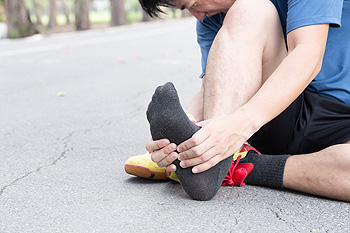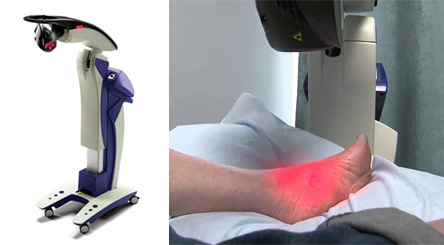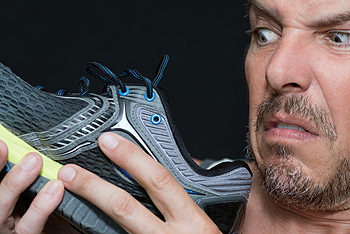 Wounds take time and attention to heal, especially when they are on the foot. Similar to injuries known as bedsores, wounds on the bottom of the feet are constantly under pressure. This pressure slows the healing process, because blood flow is weakened. Keeping pressure off the wound is essential in order to get the blood flowing back into the foot and facilitate the healing process. This can be done in easy ways, such as sitting or laying down. Standing directly on a wound probably causes some discomfort anyway, so giving it time to breathe is important. If you have an open wound on your foot and have additional questions, then it is recommended that you speak with a podiatrist to learn about the proper treatment options.
Wounds take time and attention to heal, especially when they are on the foot. Similar to injuries known as bedsores, wounds on the bottom of the feet are constantly under pressure. This pressure slows the healing process, because blood flow is weakened. Keeping pressure off the wound is essential in order to get the blood flowing back into the foot and facilitate the healing process. This can be done in easy ways, such as sitting or laying down. Standing directly on a wound probably causes some discomfort anyway, so giving it time to breathe is important. If you have an open wound on your foot and have additional questions, then it is recommended that you speak with a podiatrist to learn about the proper treatment options.
Wound care is an important part in dealing with diabetes. If you have diabetes and a foot wound or would like more information about wound care for diabetics, consult with Dr. Richard DiMario from Maine. Our doctor will assess your condition and provide you with quality foot and ankle treatment.
What Is Wound Care?
Wound care is the practice of taking proper care of a wound. This can range from the smallest to the largest of wounds. While everyone can benefit from proper wound care, it is much more important for diabetics. Diabetics often suffer from poor blood circulation which causes wounds to heal much slower than they would in a non-diabetic.
What Is the Importance of Wound Care?
While it may not seem apparent with small ulcers on the foot, for diabetics, any size ulcer can become infected. Diabetics often also suffer from neuropathy, or nerve loss. This means they might not even feel when they have an ulcer on their foot. If the wound becomes severely infected, amputation may be necessary. Therefore, it is of the upmost importance to properly care for any and all foot wounds.
How to Care for Wounds
The best way to care for foot wounds is to prevent them. For diabetics, this means daily inspections of the feet for any signs of abnormalities or ulcers. It is also recommended to see a podiatrist several times a year for a foot inspection. If you do have an ulcer, run the wound under water to clear dirt from the wound; then apply antibiotic ointment to the wound and cover with a bandage. Bandages should be changed daily and keeping pressure off the wound is smart. It is advised to see a podiatrist, who can keep an eye on it.
If you have any questions, please feel free to contact our office located in York, ME . We offer the newest diagnostic and treatment technologies for all your foot care needs.
 The most common cause for pain in the side of your foot is cuboid syndrome and it occurs when the cuboid, a small bone in the outer foot, is dislocated. This can be a result of an injury to the ankle or just simply repetitive movements that put stress on the outer foot. Unfortunately, this syndrome can sometimes be hard for doctors to diagnose because cuboid misalignments may not show up on x-rays or MRIs. However, these tests do help your doctor eliminate other possible reasons for the outer foot pain. One way doctors diagnose cuboid syndrome is by moving the foot inwards and outwards to see exactly where the pain is stemming from. After receiving a proper diagnosis, this syndrome is easily fixed. Oftentimes, a podiatrist can efficiently relocate the bone, which is followed by only minor aching. If you are feeling pain on the side of your foot and suspect that it may be cuboid syndrome, then it is strongly recommended that you consult with a podiatrist to receive effective treatment.
The most common cause for pain in the side of your foot is cuboid syndrome and it occurs when the cuboid, a small bone in the outer foot, is dislocated. This can be a result of an injury to the ankle or just simply repetitive movements that put stress on the outer foot. Unfortunately, this syndrome can sometimes be hard for doctors to diagnose because cuboid misalignments may not show up on x-rays or MRIs. However, these tests do help your doctor eliminate other possible reasons for the outer foot pain. One way doctors diagnose cuboid syndrome is by moving the foot inwards and outwards to see exactly where the pain is stemming from. After receiving a proper diagnosis, this syndrome is easily fixed. Oftentimes, a podiatrist can efficiently relocate the bone, which is followed by only minor aching. If you are feeling pain on the side of your foot and suspect that it may be cuboid syndrome, then it is strongly recommended that you consult with a podiatrist to receive effective treatment.
Cuboid syndrome, also known as cuboid subluxation, occurs when the joints and ligaments near the cuboid bone in the foot become torn. If you have cuboid syndrome, consult with Dr. Richard DiMario from Maine. Our doctor will assess your condition and provide you with quality foot and ankle treatment.
Cuboid syndrome is a common cause of lateral foot pain, which is pain on the outside of the foot. The condition may happen suddenly due to an ankle sprain, or it may develop slowly overtime from repetitive tension through the bone and surrounding structures.
Causes
The most common causes of cuboid syndrome include:
Symptoms
A common symptom of cuboid syndrome is pain along the outside of the foot which can be felt in the ankle and toes. This pain may create walking difficulties and may cause those with the condition to walk with a limp.
Diagnosis
Diagnosis of cuboid syndrome is often difficult, and it is often misdiagnosed. X-rays, MRIs and CT scans often fail to properly show the cuboid subluxation. Although there isn’t a specific test used to diagnose cuboid syndrome, your podiatrist will usually check if pain is felt while pressing firmly on the cuboid bone of your foot.
Treatment
Just as the range of causes varies widely, so do treatments. Some more common treatments are ice therapy, rest, exercise, taping, and orthotics.
If you have any questions, please feel free to contact our office located in York, ME . We offer the newest diagnostic and treatment technologies for all your foot care needs.
 Among various podiatrists, MLS Laser Therapy is often used as a successful alternative to surgery or prescription medication for treating foot pain caused by various podiatric conditions. Multiwave Locked System (MLS) Laser Therapy uses light to accelerate the body’s healing processes. During the treatment, a laser beam is moved over the skin, allowing the light energy to enter the tissue and cause the desired effect. Despite being a “laser” treatment, MLS Laser Therapy does not hurt or burn. A slight warming sensation at the site of application is normal and is a sign that inflammation is being alleviated.
Among various podiatrists, MLS Laser Therapy is often used as a successful alternative to surgery or prescription medication for treating foot pain caused by various podiatric conditions. Multiwave Locked System (MLS) Laser Therapy uses light to accelerate the body’s healing processes. During the treatment, a laser beam is moved over the skin, allowing the light energy to enter the tissue and cause the desired effect. Despite being a “laser” treatment, MLS Laser Therapy does not hurt or burn. A slight warming sensation at the site of application is normal and is a sign that inflammation is being alleviated.
MLS Laser Therapy is a successful alternative for treating any pain you may be experiencing related to certain podiatric conditions. If you are interested in MLS Laser Therapy, consult with Dr. Richard DiMario from Maine. Our doctor will assess your condition and provide you with quality foot and ankle treatment.
MLS Laser Therapy
Multiwave Locked System (MLS) Laser Therapy is a patented, FDA-cleared technology that helps relieve pain and inflammation from a number of podiatric conditions, including:
MLS Laser Therapy is an ideal alternative to surgery and prescription medication, as it has no negative side effects and encourages accelerated healing. Among its many clinical benefits, MLS Laser Therapy also:
If you have any questions, please feel free to contact our office located in York, ME . We offer the newest diagnostic and treatment technologies for all your foot care needs.
 The medical condition that is referred to as planter hyperhidrosis is defined as excessive sweating of the feet. Many patients may experience extreme discomfort, and this may be a result of shoes and socks that are frequently wet. There are several symptoms that may be associated with this ailment, and these may include foot infections such as toenail fungus or athlete’s foot, blisters on the feet that may come from excessive friction, or a strong and unpleasant foot odor. There may be preventive measures that can be implemented to ease the discomfort of plantar hyperhidrosis, including utilizing antiperspirants on the feet, wearing layers of cotton socks, which may be helpful in absorbing sweat, or taking oral medications. If you are afflicted with this uncomfortable foot condition, it is suggested to speak with a podiatrist who guides you to begin the correct treatment.
The medical condition that is referred to as planter hyperhidrosis is defined as excessive sweating of the feet. Many patients may experience extreme discomfort, and this may be a result of shoes and socks that are frequently wet. There are several symptoms that may be associated with this ailment, and these may include foot infections such as toenail fungus or athlete’s foot, blisters on the feet that may come from excessive friction, or a strong and unpleasant foot odor. There may be preventive measures that can be implemented to ease the discomfort of plantar hyperhidrosis, including utilizing antiperspirants on the feet, wearing layers of cotton socks, which may be helpful in absorbing sweat, or taking oral medications. If you are afflicted with this uncomfortable foot condition, it is suggested to speak with a podiatrist who guides you to begin the correct treatment.
If you are suffering from hyperhidrosis contact Dr. Richard DiMario of Maine. Our doctor can provide the care you need to attend to all of your foot and ankle needs.
Hyperhidrosis of the Feet
Hyperhidrosis is a rare disorder that can cause people to have excessive sweating of their feet. This can usually occur all on its own without rigorous activity involved. People who suffer from hyperhidrosis may also experience sweaty palms.
Although it is said that sweating is a healthy process meant to cool down the body temperature and to maintain a proper internal temperature, hyperhidrosis may prove to be a huge hindrance on a person’s everyday life.
Plantar hyperhidrosis is considered to be the main form of hyperhidrosis. Secondary hyperhidrosis can refer to sweating that occurs in areas other than the feet or hands and armpits. Often this may be a sign of it being related to another medical condition such as menopause, hyperthyroidism and even Parkinson’s disease.
In order to alleviate this condition, it is important to see your doctor so that they may prescribe the necessary medications so that you can begin to live a normal life again. If this is left untreated, it is said that it will persist throughout an individual’s life.
A last resort approach would be surgery, but it is best to speak with your doctor to find out what may be the best treatment for you.
If you have any questions please feel free to contact our office located in York, ME . We offer the newest diagnostic and treatment technologies for all your foot and ankle needs.
 Research has shown that heel pain is considered to be the most common form of pain in the feet. There may be several reasons why this type of pain may occur, including an injury that has happened to the Achilles tendon, a condition that is referred to as plantar fasciitis, in addition to heel spurs. If this type of pain is caused by an injury, the pain will most likely be sudden and severe. If an injury did not occur, heel pain may be experienced gradually, which may often lead to severe discomfort. A common reason why heel pain begins may be related to the type of shoes that are worn, which may lead to additional foot conditions developing. If you are experiencing any type of heel pain, it is strongly suggested to consult with a podiatrist who can determine the reason for this, and to discuss correct treatment options.
Research has shown that heel pain is considered to be the most common form of pain in the feet. There may be several reasons why this type of pain may occur, including an injury that has happened to the Achilles tendon, a condition that is referred to as plantar fasciitis, in addition to heel spurs. If this type of pain is caused by an injury, the pain will most likely be sudden and severe. If an injury did not occur, heel pain may be experienced gradually, which may often lead to severe discomfort. A common reason why heel pain begins may be related to the type of shoes that are worn, which may lead to additional foot conditions developing. If you are experiencing any type of heel pain, it is strongly suggested to consult with a podiatrist who can determine the reason for this, and to discuss correct treatment options.
Many people suffer from bouts of heel pain. For more information, contact Dr. Richard DiMario of Maine. Our doctor can provide the care you need to keep you pain-free and on your feet.
Causes of Heel Pain
Heel pain is often associated with plantar fasciitis. The plantar fascia is a band of tissues that extends along the bottom of the foot. A rip or tear in this ligament can cause inflammation of the tissue.
Achilles tendonitis is another cause of heel pain. Inflammation of the Achilles tendon will cause pain from fractures and muscle tearing. Lack of flexibility is also another symptom.
Heel spurs are another cause of pain. When the tissues of the plantar fascia undergo a great deal of stress, it can lead to ligament separation from the heel bone, causing heel spurs.
Why Might Heel Pain Occur?
Treatments
Heel pain should be treated as soon as possible for immediate results. Keeping your feet in a stress-free environment will help. If you suffer from Achilles tendonitis or plantar fasciitis, applying ice will reduce the swelling. Stretching before an exercise like running will help the muscles. Using all these tips will help make heel pain a condition of the past.
If you have any questions please contact our office located in York, ME . We offer the newest diagnostic and treatment technologies for all your foot and ankle needs.